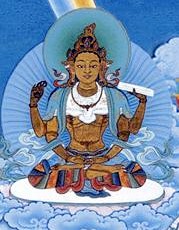Prajnaparamita: Difference between revisions
Jump to navigation
Jump to search
mNo edit summary |
m (→Literature) |
||
| Line 21: | Line 21: | ||
*[[Perfection of Wisdom Sutra in Twenty-five Thousand Lines]] | *[[Perfection of Wisdom Sutra in Twenty-five Thousand Lines]] | ||
*[[Perfection of Wisdom Sutra in Eight Thousand Lines]] | *[[Perfection of Wisdom Sutra in Eight Thousand Lines]] | ||
*[[ | *[[Seventeen mothers and sons]] | ||
*[[Verse Summary of the Prajnaparamita]] | *[[Verse Summary of the Prajnaparamita]] | ||
Revision as of 15:03, 24 April 2011

Prajñaparamita (Skt. Prajñāpāramitā; Tib. ཤེར་ཕྱིན་, ཤེས་རབ་ཀྱི་ཕ་རོ་ཏུ་ཕྱིན་པ་, sherchin; wyl. sher phyin, sherab kyi parol tu shinpa) means 'Perfection of Wisdom', or more literally, ‘transcendent wisdom’. It refers to:
- the sixth of the paramitas: perfect non-conceptual wisdom.
- the class of Buddhist literature that was mainly discovered by Nagarjuna in the second century. Its central topic is emptiness.
- the female deity who is the embodiment of transcendent wisdom.
Definition
"Prajnaparamita is the wisdom of directly realizing the non-conceptual simplicity of all phenomena, which has arrived at, or will lead one to, non-abiding nirvana."[1]
Subdivisions
According to the teachings of the Abhisamayalankara, there are four subdivisions:
- natural prajnaparamita
- scriptural prajnaparamita
- path prajnaparamita
- resultant prajnaparamita
Literature
- Heart Sutra
- Perfection of Wisdom Sutra in One Hundred Thousand Lines
- Perfection of Wisdom Sutra in Twenty-five Thousand Lines
- Perfection of Wisdom Sutra in Eight Thousand Lines
- Seventeen mothers and sons
- Verse Summary of the Prajnaparamita
Notes
- ↑ From The Words of Jikme Chökyi Wangpo by Khenpo Tsöndrü.